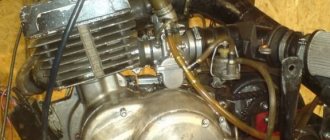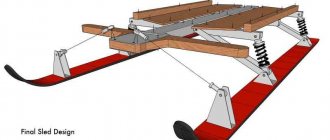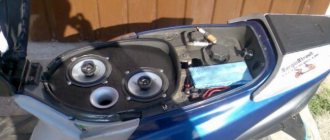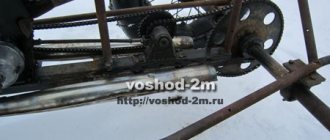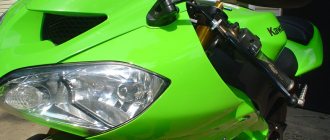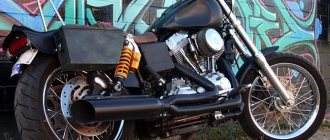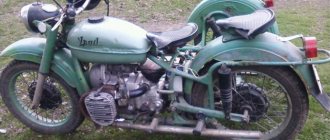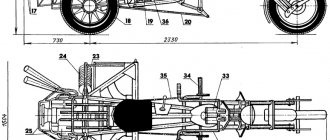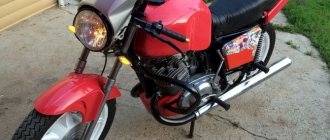- home
- Engine
- …
I often receive questions on my blog regarding the power unit, namely its boring. It is not entirely clear to beginners why this process occurs at all, what it gives and how many times it can be done. Personally, when I personally overhauled the engine, we had to sharpen the block and then “sleeve” it, all this happened on my MOSKVICH 2140. In modern realities, with a completely different level of lubricants and coolants, such repairs are VERY rare, now this is done more for tuning, but everything is in order...
First, a little definition
Block boring is the process of physically grooving the walls of the engine cylinders (on special machines) to restore the correct (almost ideal) geometric shape.
It is done during major engine repairs , or for tuning, mainly to increase power.
What is it done for?
As I wrote before (20-30 years ago), the main task was repairs. It is worth noting that the power unit and all its main parts experience constant loads, these are cylinders, pistons, rings, crankshaft, camshaft (shafts), valves, liners, etc.
The piston has especially strong loads; it rubs against the cylinder of the block, and this process is repeated hundreds - thousands of times in just one minute. This is where maximum wear occurs, the metal of the walls is ground off, and the block begins to lose its original round shape. If you exaggerate it, it becomes oval, not round. The fit of the pistons (namely its rings) to the walls begins to deteriorate, accordingly, the combustible mixture or exhaust gases begin to flow into the crankcase, and oil, on the contrary, into the working chamber - the power drops, the power unit begins to “eat oil”! Gray (bluish) smoke begins to fly from the muffler . These are the first bells.
To be fair, sometimes compression rings get stuck, compression will also drop and smoke will start pouring out, you will definitely need to open the engine and figure it out
Previously, there were no normal oils, they thickened wildly in winter, burned in summer, lubricity was low - engines had to be “overhauled” after 30 - 50,000 miles, and trucks only more often. In winter (oddly enough) the units overheated, all because, again, there were no normal antifreeze or antifreeze, they poured water that froze, forming traffic jams here and overheating was not far away, albeit local, even if not for long - BUT THIS WAS ENOUGH.
Now technology has stepped FAR forward. There are various semi-synthetic or synthetic formulations, not only of oils, but also of coolants. Therefore, now the engine runs for a long time! The resource from repairs has increased many times, if not tens of times.
Of course, after 250,000 (on average) kilometers there will still be repairs, but just think about the mileage! Medium-sized cities rarely get 15,000 people a year, so 250,000 will last about 15 years.
The first reason is, you guessed it repair , if possible (more on this below), the oval shape or scuffs inside the cylinder are removed by boring, more pistons are installed and the engine lives for many more thousands of kilometers.
The second reason is simply an increase in volume. Again, if the block (or rather its walls) allows, boring occurs, pistons of larger diameter are installed, they have a greater ability to suck in the air-fuel mixture. If you exaggerate a piston with a diameter of 79.8 mm, it will suck in much less than with a diameter of 82 mm. The fuel burns more, and accordingly the pressure of the ignited mixture on the piston is higher, so you get an increase in power. THEY MAKE MAINLY tuners for pumping up their “iron” horses.
Some difficulties of engine tuning
True, in order to ensure this result, it will be necessary to intervene in the arrangement of air and gas lines, and to alter the fuel and exhaust mechanisms.
In the easiest case of tuning, you can simply replace the connecting rods with longer ones and install repair sleeves, pre-bored to the required parameters.
Aluminum and cast iron
Before telling you about the process itself, it’s worth mentioning that there are different materials for making blocks. These are cast iron (it appeared first) and aluminum. I will have a separate article about them, but today I will simply tell you which ones can be SHARPENED AND WHICH NOT!
Cast iron is an almost ideal option, cheap, reliable, durable. They last for a long time, and often give in to grooving. We remove the required size, install new repair pistons, and the engine is back in service. However, they also have significant disadvantages - weight (it is three times heavier than aluminum), heat dissipation (more passages and channels are needed to effectively cool it), and corrosion (the walls can rust from prolonged inactivity).
Aluminum is lightweight, has the best heat dissipation, and is not subject to corrosion. A big plus is its weight; now many manufacturers are chasing to reduce the weight of their cars; the aluminum version gives them greater savings, and therefore lower fuel consumption of the car. BUT this metal is soft and short-lived compared to cast iron. For better wear resistance, the inner walls are coated with a special coating with a high silicon content. THEN and only then can the motors operate for a sufficiently long time.
THAT'S WHY aluminum motors are often not sharpened; many craftsmen call them disposable! Because the durable top layer in the cylinders cannot be removed
Which motors can be sharpened and which cannot?
As you know, the cylinder block can be made of cast iron or aluminum. The first option, despite some disadvantages, which include high mass and low heat dissipation, has good strength and is ideal for turning. An aluminum block, on the contrary, is much lighter and more efficient at removing heat.
However, the walls of its cylinders are coated with a special wear-resistant compound, which is why it is not recommended to grind them. This procedure will simply remove the coating from the walls, causing the cylinders to lose their strength and not last long.
How does the boring process work?
It is simpler than it seems at first glance. HOWEVER, you are unlikely to be able to do anything with your own hands. The engine is completely disassembled; BORING on the machine will not work. The block is removed and attached to the bed of a special machine, and it is fixed level!
If the boring process is carried out for repair, that is, there is a lot of wear (an ellipse has formed), then a series of measurements are made using micrometric pointer instruments - how much needs to be removed from the walls. AND IS THIS AT ALL POSSIBLE or do you immediately need to tune in to “GIZOVKA”.
Next, work is performed on a vertical boring machine. REMEMBER YOU NEED TO SEEK a highly qualified craftsman with good equipment, and not one that falls apart and cannot hold the EXACT size you need.
Next, the master stuffs - either a mirror inside the cylinder, or does honing (this is the finishing treatment of the walls to remove all risks and burrs, so that the walls and rings get used to each other faster), this is done first with a large abrasive, then with a fine one. Both methods have their fans, and which one to choose is up to everyone; the debate still does not subside.
And the final stage is assembly. Already for repair dimensions, spare parts are purchased, namely pistons, rings, all this is subsequently installed, connected to the crankshaft and the entire engine is assembled.
Everything is so simple when there is no need for sleeves, but here it’s not so simple.
Making a “cutter”
In this operation we will need: a birch log, calipers, a marker, a chisel, a saw, a cylinder (the one we are going to sharpen), a piston (new and old), a rasp (you can use a file), a drill, a long bolt with a nut or a hairpin with two nuts , sandpaper sheets “10”, “6”, “5” and “0” (on a fabric basis - not suitable on paper). There are a few caveats - the stud or bolt must be at least 8mm in diameter. The best solution would be 12mm. Sandpaper is selected independently, depending on the type of boring. It is advisable to go through the “rough process” and bring it “to clean water”, and not to drive the rough one until you are blue in the face. Then fix the finishing one, and buy and select a new piston.
Let's start - measure the sleeve with a caliper:
Let's take an allowance of 10mm and measure it on the already trimmed log:
Let's outline approximately where we have “more meat”, and set some simple markings there and drill:
Immediately take a larger chisel and chop off the excess “meat”. Shape it into a cylinder.
But the shape of a cylinder will not work, it will turn out something like an oval:
The next step is to tighten the resulting cylinder onto the stud/bolt. Tighten until your teeth creak. When inserted into the drill, tighten until your teeth creak - it will unwind with a bang. If you tighten it harder, it won’t run away. Now secure the drill, make a stop for the chisel, and unwind the cylinder by pressing the gas on the drill. Take technology breaks more often. During breaks, tighten all nuts. If it comes loose, the results could be disastrous.
By substituting a chisel (smoothly substituting a chisel!) we ensure that we first get an oval:
Then the shape will remind us of a cylindrical object:
Later you will get a natural, perfect cylinder. I think there is no need to explain that the fine-tuning was no longer carried out with a chisel, but with a rasp, and later even with a file.
You should end up with a long wooden piston for the cylinder. Only well weakened. Somewhere by 0.3-0.6 mm.
Something like that:
This is an example of relaxation.
Next, we will make a technological cut in a wooden blank:
And you need to make a “latch” for it, that is, a latch. So that the sandpaper does not run away from us somewhere far away. Here I honestly admit that I stepped in the wrong place.
I made it wooden:
And it looked like this:
But when I started refilling, I realized that it didn’t hold well. The answer did not take long to arrive - a 3mm welding electrode worked perfectly as a clamp.
Make a fastener for the drill - it tends to run away from you!
Now let's see how we will have a working area:
Well, we have made our workplace. We can start taking measurements.
Sleeves as a method of repair
And in cast iron and aluminum blocks, there is such a thing as “Sleeve”, that is, special sleeves are installed - these are cylindrical (usually cast iron) hollow parts similar to a large piece of pipe.
They are pressed into the engine block under temperature and sit firmly in place. The main purpose is to make the motor stronger (in the case of the aluminum version), make the structure maintainable, and increase its service life. The sleeves can be made of high-strength alloy gray cast iron, as well as regular ones (it is worth noting that there are options with thin steel sleeves; this also exists, for example, ISUZU machines), there are also aluminum options, but they are not so common.
The big advantage is that when the liner wears out, it seems to take the entire blow upon itself. You simply pull it out (grind it out), install a repair one, or even one of the same size. Change the pistons and rings (most likely, repairs will be needed). And the engine runs normally again.
However, there are engines that are not “lined” from factories, both aluminum and cast iron. If we can bore a cast-iron block, and also “sleeve” it with a version of gray cast iron - install larger pistons (or the same ones) and roll on - because there is no difference in the thermal expansion of the metal. But aluminum, due to its complex manufacturing technology, is often not subject to this. A fair question arises - is it possible to put cartridges in it?
Undeniable economic benefit
At the same time, the cost of boring makes it much more profitable than purchasing a new similar block. There is no great need to expand the cylinders only for the owner of a Soviet car made in the 1980s and 1990s, any spare parts for which can be found almost free of charge.
Aluminum block and sleeves
Guys, this is a VERY broad topic, perhaps I will write about it a little later. In the meantime, I’ll let you understand a few basic postulates.
Aluminum options are indeed often not recommended to be bored (although not all of them) and this is the point. First, let’s look at the manufacturing technology of modern blocks:
- When casting, thin-walled thin cast iron sleeves are installed at the factory, the wall thickness is 2 - 3 mm. Such options are called “dry with cast iron sleeves . Boring of this option is acceptable, and repair pistons and rings are produced for them. Installed on cars such as VOLVO, Land Rover, HONDA, SUBARU, NISSAN, SUZUKI and some others.
- All-aluminum monoblocks using SILUMAL (developed by MAHLE). There is a cast aluminum body here, but the walls from the inside are subjected to complex chemical-thermal treatment, after which a high concentration of silicon is formed on the walls; this material prevents the rings and pistons from quickly wearing out the walls and the resource increases to 150 - 200,000 km. The layer is quite thick and can also be bored out a LITTLE; for such engines, repair kits are available that increase the cylinder size by 0.5 - 1 mm. Such options are installed on many models of Mercedes, BMW, AUDI, PORSCHE and some other cars.
- NICASIL monoblock technology . Here, too, a durable coating of only a mixture of nickel and silicon carbide is applied to the surface of the cylinder walls. It is much thinner than its predecessor, and therefore cannot be repaired! The manufacturer has not provided repair capabilities and does not provide repair kits. Installed on some BMW models and others.
“Dry liners” and SILUMAL are quite repairable, that is, if your compression has dropped due to wear from high mileage, then you can easily remove 0.5 - 1 mm, install a repair piston group and continue riding. ALSO, for some SILUMAL variants, manufacturers produce ORIGINAL aluminum sleeves; they are needed when the bore is more than 1mm. True, their cost simply goes off scale, up to 200 EUROS per one, but there is an exceptional ratio of metals and the possibility of complete restoration (also in some cases you can buy one piece for one cylinder). The only EXCEPTION can be that the block wall is very badly damaged, to a depth greater than repair boring is possible. However, such blocks may not be saved by anything; fatal damage may occur, for example, the piston has turned.
NICASIL – it is virtually impossible to restore! That is, as the manufacturer assures, this is actually a disposable motor. As I wrote above, he does not have spare parts approved by the manufacturer. But in the country we live in, there are a lot of companies that make sleeves specifically for Nicasil, and cast iron with a small wall (2 - 3 mm), there are also craftsmen who can combine this whole thing! However, you need to remember about thermal expansion and various metals. Most likely, Uncle Vasya will not be able to do it efficiently in the garage. However, prices for new units, if you take top-end BMWs, can reach up to 5000 - 7000 EURO, force you to look for such masters.
This is such a large material, if it’s difficult to read, then watch the video version, it’s more detailed and simple.
I’ll end here, I think it was useful. SINCERELY YOUR AUTOBLOGGER
Similar news
- After changing the oil, the engine is noisy. Details + video version
- Engine flushing oil. How to choose and whether you need it or...
- Running in a new car - is it necessary? Or you can immediately “fever...
Add a comment Cancel reply
Real opportunity to increase power
Effectively boosting a motor requires lengthy engineering calculations and the most accurate implementation of the drawn up project. At the same time, it is important to be aware that not all types of engines allow any kind of pumping.
Noticeable changes in the dynamics of the car will appear even with an expansion of the cylinder diameter by only 2 mm. This will be quite enough to increase the pressure of the gases on the pistons.
Indirect signs of the appearance of an ellipse
In a number of cases, the fact that the cylinder is no longer round can be guessed by the following deviations from the standard parameters:
- Reduced compression;
- Excessive consumption of engine oil;
- Oil clogging of spark plugs;
- Exhausts acquire a bluish tint.
Types of honing machines
For service work of this kind, three types of machines are produced:
- Vertical boring, which are the most widely used;
- Jig boring machines, which allow you to set a particularly precise position of the cutter and accurately track the work process. Machines of this type are quite expensive and therefore can only be found in large car repair shops;
- Horizontal boring machines, which are modified milling machines. Such equipment is almost never used today, as it operates with large errors.
How to bore a cylinder block at home
Novice craftsmen who try to do everything with their own hands ask the following question: is it possible to grind the engine block in a garage and how to do it.
You can bore the engine block yourself without a machine, but this requires a lot of time and patience, but now I still bore the engine block in a specialized workshop, it’s less hassle. But before, I often bored motorcycle cylinders myself, without a machine, using a manual mandrel.
This method of boring a cylinder can be used both for boring a machine cylinder block and a motorcycle cylinder.
The only thing you will have to do is turn to a lathe to have him turn out a mandrel; for boring a cylinder, it is shown in the figure.
A mandrel for boring a cylinder can be turned from wood, the principle of turning is this: if you are planning to bore a cylinder that has a diameter of 76 mm, then the mandrel must be turned with a diameter of 74 mm, and the length of the cylinder is 150 millimeters or more.
After the turner has turned the mandrel, you need to drill a hole in it for the knob, and use a hacksaw to cut a groove 10 millimeters deep along the mandrel, as shown in the figure.
Erasing the cylinder with piston rings
A typical reason for distortion of the factory geometry at a certain stage of the run is the friction of the rings on the glass. Under the influence of the pistons, it acquires an oval or conical shape.
This defect cannot be detected with your own eyes, but high-precision instrumental measurements can reveal it.
Boring, polishing, honing
Then the master himself or in the process of negotiations with the client decides what kind of repair actions should be carried out. The most important task of a car mechanic at this stage is to accurately adhere to the dimensions of the bore.
It itself does not take much time, especially if it is carried out automatically under the full control of a computer.
Next, grinding to a mirror smoothness or honing is carried out. Given that there will not be even the slightest deviation from the ideal cylinder on the mirror surface of the cup, practice shows that standard honing creates the prerequisites for more successful grinding of piston rings to cups.
